Lecture 4: Types, Memory, Exception
Learning Outcomes
After this class, students should:
- understand the differences between compile time and run time
- understand the basic rules for type conversion in Java, including the differenes between narrowing conversion and widening conversion.
- understand the concept of subtyping in general and the subtype relations in Java
- understand what is type covariance and that Java arrays are covariance.
- understand when memory are allocated/deallocated from the heap vs. from the stack
- understand the concept of call stack in JVM
- understand how Java call by reference and call by value
- know about the keywords
null,try,catch,finally,throw, andthrows. - appreciate why exceptions is a useful way of handling errors
- aware of the differences between errors, unchecked exception, and checked exception in Java
- be able to trace through the control flow of
try/catch/finallyblock - how to generate an exception and create a new exception
- not commit bad practices when using exceptions
java and javac
Now that we have gone through the basic concepts of OO programming, let's take a step away from OO for the moment and look at some other important features of Java.
In your Lab 0, we showed you how to use javac to compile your Java program and java to execute your program.
javac is a compiler. It reads in Java source files as a string, parses the string for syntax errors, and converts the Java code into an intermediate binary format called the bytecode. Bytecode is an instruction set akin to hardware instructions but is typically executed by a software interpreter.
This behavior is different from what gcc does for C programs. gcc produces native machine code, corresponding to hardware instructions. As such, a C program your gcc produced on your home machine will not run on sunfire.
Java designers (led by James Gosling) wanted a language that can be compiled into a form that is platform and hardware independent, thus, they developed their own runtime environment called the Java Virtual Machine (JVM), which interprets and executes the bytecode, optimizes the execution, and manages the memory of Java programs. Bytecode produced (the .class files) on one platform can run other platforms.
Other Bytecode Languages
Many other programming environments offer compilation to bytecode. Python, for instance, compiles Python code into .pyc files, which contain Python bytecode. Facebook's HHVM compiles PHP into bytecode. Google's V8 compiles Javascript into bytecode too.
Other JVM Languages
While JVM was initially designed for Java, its popularity has led to the development of other languages that compile to JVM bytecode and run on JVM, such as Clojure, Groovy, Scala and Kotlin.
Other Java Compilers
While we stick to the Java 9 compiler from Oracle for CS2030, there are other Java compilers: ecj is the Java compiler from Eclipse -- if you use Eclipse IDE, this is the default compiler. gcj is the GNU Java Compiler (which has been removed from GCC 7 onwards).
Once you produce the .class files containing the bytecode corresponding to the code you have written, you can pass the bytecode to JVM for execution by invoking the java command. This is when your code gets executed -- objects get created and stored in memory, methods get called, etc.
Compile Time vs Run Time
It is important to understand the difference between the two stages, compile time (when we invoke javac) and run time (when we invoke java).
During compile time, the compiler does not always know what value a variable will take, nor will it know the sequence of execution of the programs. As such, the compiler opts to be conservative and only makes the decision on what it knows for sure. We have encountered this before -- recall our discussion on late binding:
1 2 3 | for (Printable o: objs) { o.print(); } |
The compiler cannot always be sure what is the class of the object the variable o will refer to during runtime, and thus, it cannot be sure which version of print method will be executed.
In another example, we have
1 2 3 | Circle c = new Circle(new Point(0,0), 10); Printable c2 = c; c2.getArea(); |
At compile time, c2 has a type Printable, and we try to invoke getArea which is a method available in Circle, not Printable. Even though if we trace through the three lines of code above, we (the humans) can be sure that c2 is pointing to a Circle object and it is fine to call getArea, the compiler has to be conservative as it is designed to work on arbitrarily complex programs with an unknown sequence of execution. The compiler thus does not allow us to call c2.getArea().
jshell
If we compile a program with javac and then execute it with java, we have two distinct phases. An error reported by javac occurs during compilation and is a compile time error. An error reported by java occors during run time, and is a run time error.
If we "play" with our classes and with Java syntax using jshell, however, the differences between compile time and run time error are blurred. jshell is an "REPL" tool, which stands for "read-eval-print loop", and it does exactly what the name says: it repeatedly reads in a Java statement, evaluates the statement, and prints out the result. The reading step is analogous to compiling, while the evaluating and printing steps are analogous to running a program. So, jshell produces an error message, it could be due to an error triggered by either compile time or run time.
1. Types
The above discussion brings us back to the topic of types. Unlike C which is not type safe or Python and Javascript which are weakly typed, Java belongs to a class of programming language which is statically typed and enforces type safety through a rich set of rules. Understanding these rules and appreciating them is important to writing good and general Java programs, as well as picking up other statically and strongly typed programming languages.
Type Conversion
Sometimes a programmer knows better than the compiler the intention of the program. In this case, it is useful for a programmer to override the compiler's decision. One possible such override is to force the type of a variable to be something more appropriate, through type casting.
We have seen type casting in action when we discussed about type safety (see Lecture 1). Recall that, in C, we can type cast two seemingly incompatible types to each other. We have also seen it last week when we cast an Object variable to a Circle when we discuss overriding of the equals() method.
Type casting is a form of type conversion, in particular, an explicit type conversion.
Let's talk about implicit type conversion first. Implicit conversion can happen in several contexts:
- Assignment, for instance, assigning a variable of type
Circleto a variable of type `Shape. - Method invocation, for instance, when you pass a variable of type
Circleto a method expectingShape. - String conversion, when one of the operands of
+is aStringand the other is not, in which case it will be converted toString(by callingtoString()).
Suppose we have a reference type S and T is a subtype of S (denoted T <: S), then converting T to S is checked at compile time. This conversion is known as widening reference conversion.
The converse is not true. If we want to convert S to T (known as narrowing reference conversion), then we need explicit casting. Such conversion is checked at run time, and it may cause an exception.
1 2 3 4 5 6 7 8 9 10 11 12 13 | class S { } class T extends S { } class U extends S { } S s1, s2; T t = new T(); U u = new U(); s1 = t; // always OK since this is a widening reference conversion. s2 = u; // always OK since this is a widening reference conversion. t = s1; // not allowed since it is a narrowing reference conversion. t = (T)s1; // explicit conversion allowed by compiler, no problem during run time. t = (T)s2; // explicit conversion allowed by compiler, but cause run time error. |
Java subtyping and conversion specification
We are not going through all the gory details of Java subtyping and type conversion rules. Chapter 5 of Java Language Specification succinctly and precisely defines all the rules on this topic. For those students who are interested, you can check it out. Otherwise, we will discover some of the other rules along the way as we learn more about Java in practice.
Subtyping
We have seen how subtyping works in Java: we say that if a class T extends from class S or implements interface S, T is a subtype of S. The notion of subtyping, however, is more general than that. In the study of programming languages, we say that T is a subtype of S if a piece of code written for variables of type S can also safely be used on variables of type T. In the context of Java and other OO languages, inheritance and implementation of interfaces satisfy these conditions. In other languages, however, we can create subtypes without these OO notions. In Ada, for instance, we can create a subtype by restricting the range of values of a type. E.g., we can create a subtype digit from the type int, restricting its value to ranging between 0 and 9.
With this more general notion of subtyping, we can define subtype relations between the primitive types, as follows:
byte <: short <: int <: long <: float <: double; and char <: int
We can also extend the notion of widening conversion and narrowing conversion to primitive types.
Variance of Types
Given a type T, we can create other complex types that depend on T. For instance, we can have an array of type T, a generic class parameterized by T (next lecture), a method that takes in T and returns T, etc.
The term variance of types refers to how these more complex types relate to each other, given the relationship between the simpler types.
Suppose A(T) is the complex type constructed from T. Then we say that
- A is covariant if T <: S implies A(T) <: A(S),
- A is contravariant if T <: S implies A(S) <: A(T),
- A is bivariant if it is both covariant and contravariant, and
- A is invariant if it is neither covariant nor contravariant.
For example, in Java, arrays (of reference type) are covariant. This means that, T[] is a subtype of S[], if T is a subtype of S. Based on the type conversion rule, it is OK to assign any array of reference type to an array of Object objects, or pass an array of reference type to a method that expects an array of Object objects. This decision (of making Java arrays covariant) makes it possible to write very generic method that operates on array, as provided by the Java utility class Arrays.1
We will see examples of complex type A that is invariant and contravariant later in this module.
2. Heap and Stack
As mentioned earlier, JVM manages memory of Java programs while its bytecode instructions are interpreted and executed. Different JVM implementation may implement these differently, but typically a JVM implementation partitions the memory into several regions, including - method area for storing the code for the methods; - metaspace for storing meta information about classes; - heap for storing dynamically allocated objects; - stack for local variables and call frames.
Since the concepts of heap and stack are common to all execution environments (either based on bytecode or machine code), we will focus on them here.
The heap is the region in memory where all objects are allocated in and stored, while the stack is the region where all variables (including primitive types and object references) are allocated in and stored.
Considers the following two lines of code.
1 2 | Circle c; c = new Circle(new Point(1, 1), 8); |
c. When Java executes this line of code, it allocates some memory space for an object reference for c, the content is initialized to null. Since c is a variable, it resides in the stack.
null in Java
null is a special value for the object reference, that signifies that this reference is not pointing to any object. This is similar to the null in Javascript, NULL macro in C, nullptr in C++11, None in Python, nil in Objective-C. (Again, you see here computer scientists just can't agree on names!) Sir Tony Hoare (who also invented quicksort) famously apologized for inventing the null pointer. He calls it his billion-dollar mistake.
Line 2 creates a new Circle object. When Java executes this line of code, it allocates some memory space for a Circle object on the heap. The memory address of this memory space becomes the reference of the object and is assigned to the variable c.
This is shown in the figure below2.
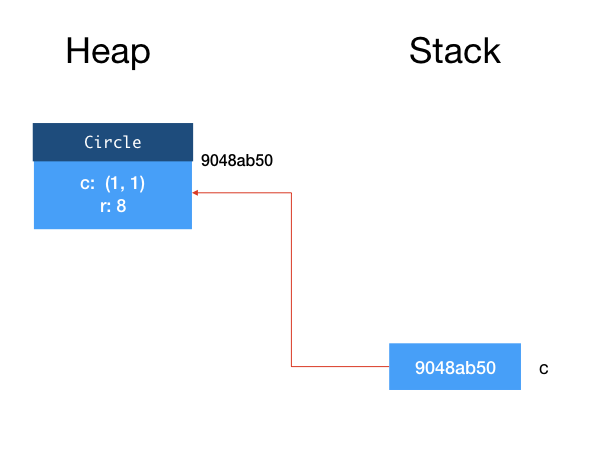
The first argument to Circle constructor is also an object, so to be more precise, when Line 2 above is executed, a Point object is also created and allocated on the heap. So the field c inside Circle is actually a reference to this object.
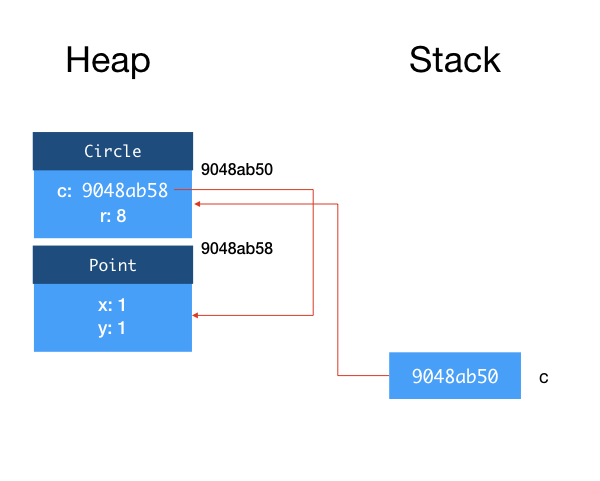
Now, let's look at a slightly different example.
1 2 3 4 5 6 | Circle c; Point center; double radius; radius = 8; center = new Point(1, 1); c = new Circle(center, radius); |
In the second example, we have three variables, c, center, and radius . Lines 1-3 declare the variables, and as a result, we have three variables allocated on the stack. Recall that for object references, they are initialized to null. Primitive type variables (e.g., radius) are initialized to 0.
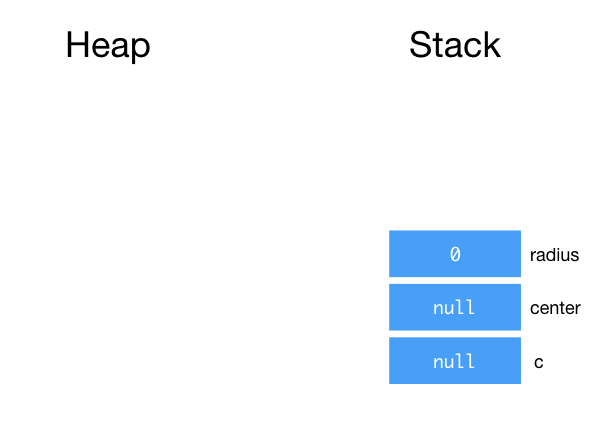
After Lines 4-6, we have:
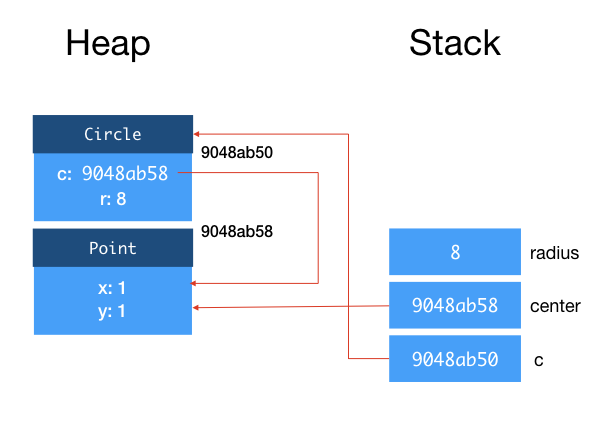
Call Stack
Now, let's look at what happens when we invoke a method. Take the distanceTo method in Point as an example:
1 2 3 4 5 6 7 | class Point { private double x; private double y; public double distanceTo(Point q) { return Math.sqrt((q.x - this.x)*(q.x - this.x)+(q.y - this.y)*(q.y - this.y)); } } |
1 2 3 | Point p1 = new Point(0,0); Point p2 = new Point(1,1); p1.distanceTo(p2); |
After declaring p1 and p2 and creating both objects, we have:
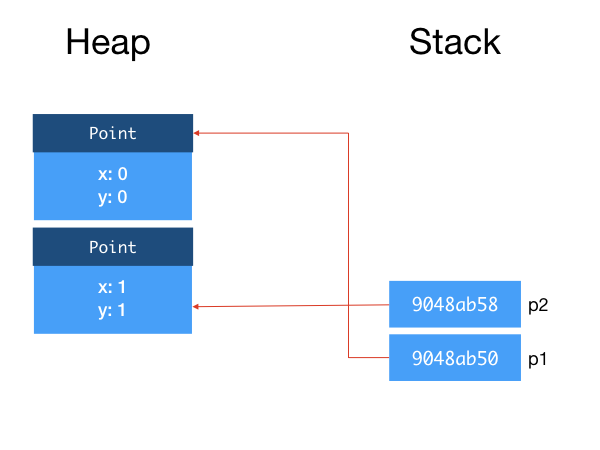
When distanceTo is called, JVM creates a stack frame for this instance method call. This stack frame is a region of memory that tentatively contains (i) the this reference, (ii) the method arguments, and (iii) local variables within the method, among other things34. When a class method is called, the stack frame does not contain the this reference.
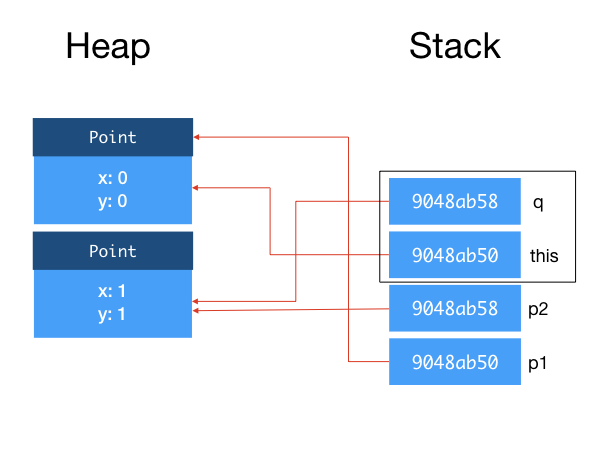
You can see that the references to the objects p1 and p2 are copied onto the stack frame. p1 and this point to the same object, and p2 and q point to the same object.
Within the method, any modification done to this would change the object referenced to by p1, and any change made to q would change the object referenced to by p2 as well.
After the method returns, the stack frame for that method is destroyed.
Let's call the move function from your Lab 0, with arguments (double theta, double d).
1 2 3 | double theta = Math.PI/4.0; double distance = 1; p2.move(theta, distance); |
Again, we create a stack frame, copy the reference to object p2 into this, copy theta from the calling function to theta the argument within the method, copy distance from the calling function to d the argument within the method. Recall that, in this function, you actually change the x and y of this to move p2.
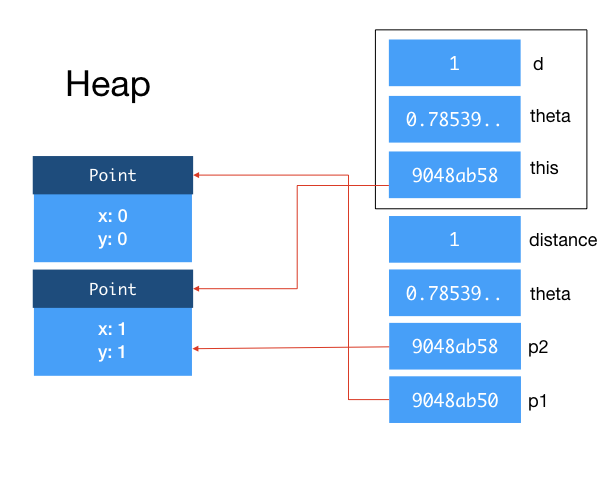
What is important here is that, as theta and distance are primitive types instead of references, we copy the values onto the stack. If we change theta or d within move, the theta and distance of the calling function will not change. This behavior is the same as you would expect in C. However, unlike in C where you can pass in a pointer to a variable, you cannot pass in a reference to a primitive type in any way in Java. If you want to pass in a variable of primitive type into a method and have its value changed, you will have to use a wrapper class. The details of how to do this are left as an exercise.
To summarize, Java uses call by value for primitive types, and call by reference for objects.
If we made multiple nested method calls, as we usually do, the stack frames get stacked on top of each other. For instance, in Lab 0, main calls solve, which calls the Circle constructor, which calls the angleTo. When JVM is executing angleTo, the call stack contains the stack frames of (in order of top to bottom): angleTo, Circle constructor, solve, and main.
One final note: the memory allocated on the stack are deallocated when a method returns. The memory allocated on the heap, however, stays there as long as there is a reference to it (either from another object or from a variable in the stack). Unlike C or C++, in Java, you do not have to free the memory allocated to objects. The JVM runs a garbage collector that checks for unreferenced objects on the heap and cleans up the memory automatically.
3. Exceptions
One of the nuances of programming is having to write code to deal with exceptions and errors. Consider writing a method that reads in a series of x and y coordinates from a file, not unlike what you have seen in Lab 0. Here are some things that could go wrong:
- The file to read from may not exist
- The file to read from exists, but you may not have permission to read it
- You can open the file for reading, but it might contain non-numeric text where you numerical values
- The file might contain fewer values than expected
- The file might become unreadable as you are reading through it (e.g., someone unplugs the USB drive)
In C, we usually have to write code like this:
1 2 3 4 5 6 7 8 9 10 11 12 13 14 15 16 17 18 19 20 21 22 23 | fd = fopen(filename,"r"); if (fd == NULL) { fprintf(stderr, "Unable to open file. "); if (errno == ENFILE) { fprintf(stderr, "Too many opened files. Unable to open another\n"); } else if (errno == ENOENT) { fprintf(stderr, "No such file %s\n", filename); } else if (errno == EACCES) { fprintf(stderr, "No read permission to %s\n", filename); } return -1; } scanned = fscanf(fd, "%d", &num_of_points); if (scanned == 0) { fprintf(stderr, "Unable to scan for an integer\n"); fclose(fd); return -2; } if (scanned == EOF) { fprintf(stderr, "No input found.\n"); fclose(fd); return -3; } |
Out of the lines above, only 2 lines correspond to the actual tasks, the others are for exception checking/handling. How uncool is that? Furthermore, the actual tasks are interspersed between exception checking code, making reading and understanding the logic of the code difficult.
The examples above also have to return different values to the calling method, because the calling method may have to do something to handle the errors. Note that the POSIX APIs has a global variable errno that signifies the detailed error. First, we have to check for different errno values and react accordingly (we can use perror, but that has its limits). Second, errno is global and we know that using global variable is bad practice. In fact, I am not even sure that code above works because fprintf in Line 3 might have changed errno!
Then, there is the issue of having to repeatedly clean up after an error -- here we fclose the file if there is an error reading, twice. It is easy to forget to do so if we have to do this in multiple places. Furthermore, if we need to perform more complex clean up, then we would end up with lots of repeated code.
Fortunately, Java supports try/catch/finally control statements, which is a way to group statements that check/handle errors together making code easier to read. The Java equivalent to the above is:
1 2 3 4 5 6 7 8 9 10 11 12 13 14 15 16 17 18 | try { reader = new FileReader(filename); scanner = new Scanner(reader); numOfPoints = scanner.nextInt(); } catch (FileNotFoundException e) { System.err.println("Unable to open " + filename + " " + e); } catch (InputMismatchException e) { System.err.println("Unable to scan for an integer"); } catch (NoSuchElementException e) { System.err.println("No input found"); } finally { if (scanner != null) scanner.close(); } |
Here Lines 2-4 keep the basic tasks together, and all the clean up tasks are grouped together in Lines 18-19. Lines 8-16 handle the exceptions. We no longer rely on a global variable to convey the type of exceptions, or special return value to indicate exceptions. What if we want the calling method to handle the exception? Then, we simply do not do anything (i.e., do not catch the exception) and let the exception propagates to the calling method automatically.
Error vs. Exception in Java
We have been using the term error and exception loosely. Java has different classes for Error and Exception. Error is for situations where the program should terminate as generally there is no way to recover. For instance, when the heap is full (OutOfMemoryError) or the stack is full (StackOverflowError). Exceptions are for situations where it is still possible to reasonably recover from the error.
Combining Multiple Catches
In cases where the code to handle the exceptions is the same, you can
1 2 3 | catch (FileNotFoundException | InputMismatchException | NoSuchElementException e) {
System.err.println(e);
}
|
Here is a more detailed description of the control flow of exceptions. Consider we have a try-catch-finally block that catches two exceptions E1 and E2. Inside the try block, we call a method m1(); m1() calls m2(); m2() calls m3(), and m3() calls m4(). In a normal (no exception) situation, the control flow looks like this:
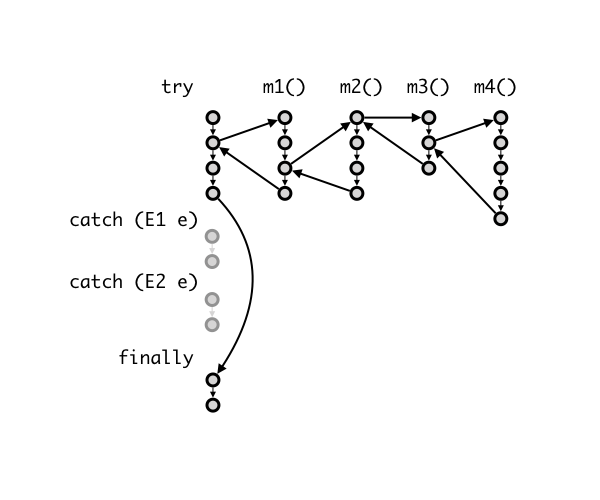
The statements in try block are executed, followed by the statements in finally block.
Now, let's suppose something went wrong deep inside the nested call, in m4(). One of the statement executes throw new E2();, which causes the execution in m4() to stop. JVM now looks for the block of code that catches E2, going down the call stack, until it can find a place where the exception is handled. In this example, we suppose that none of m1()-m4() handles (i.e., catch) the exception. Thus, JVM then jumps to the code that handles E2. Finally, JVM executes the finally block.
Note that the finally block is always executed even when return or throw is called in a catch block.
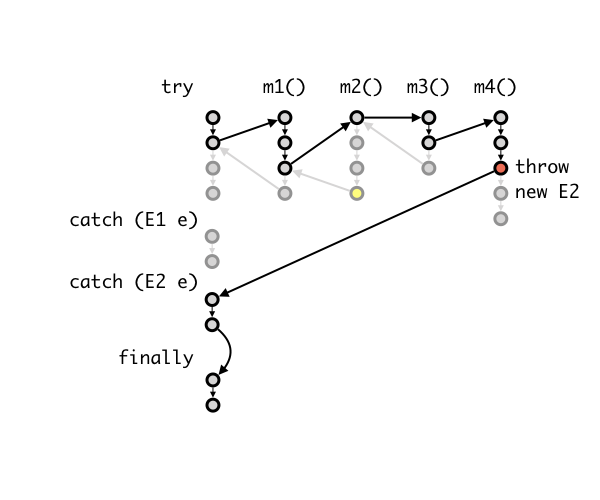
Checked Exceptions
There are two types of exceptions in Java: checked and unchecked exceptions:
- A checked exception is something that the programmer should anticipate and handle. For instance, when you open a file, you should anticipate that in some cases, the file cannot be open.
- An unchecked exception is something that the programmer does not anticipate, and usually is a result of a bug. For example, when you try to call
p.distanceTo(q)butpisnull,NullPointerExceptionwill be thrown.
We need to either catch all checked exceptions or let it propagate to the calling method. Otherwise, the program will not compile.
For unchecked exceptions, even though we could catch it, it makes more sense to eliminate the bugs. In Java, unchecked exceptions are subclasses of RuntimeException. All Errors are unchecked.
All methods that throw checked exception need to specify the checked exception(s). For example, if we want to put the code to open a file and read an int from it into a function, and want the calling function to deal with the exception, this is what we should do:
1 2 3 4 5 6 7 8 | public static int readIntFromFile(String filename) throws FileNotFoundException { FileReader reader = new FileReader(filename); Scanner scanner = new Scanner(reader); int numOfPoints = scanner.nextInt(); scanner.close(); return numOfPoints; } |
Note Line 2 specify that this method might throw FileNotFoundException.
A checked exception must be either caught or thrown to calling function, except main, which has no calling function to throw to. If main does not catch a checked exception, the program exits, and the exception is revealed to the user -- this is generally considered a bad programming practice.
The two other exceptions from the examples above InputMismatchException and NoSuchElementException are subclasses of RuntimeException, and therefore are unchecked.
Generating Exception
The Circle constructor in Lab 0 requires the distance d between two input points to be 0 < d \le 2r. If the condition is violated, you are asked to return an invalid circle. A better way is to throw an unchecked exception IllegalArgumentException if one of the above two conditions is met.
1 2 3 4 5 6 7 | public Circle(Point p, Point q, double r, boolean centerOnLeft) { if (p.distanceTo(q) > 2*r) { throw new IllegalArgumentException("Input points are too far apart"); } if (p.equals(q)) { throw new IllegalArgumentException("Input points coincide"); } |
Note that difference between throw and throws: the former is to generate an exception, the latter to specify that the exception(s) thrown by a method.
If you find that none of the exceptions provided by Java meet your needs, you can create your own exceptions, by simply inheriting from one of the existing ones. But, you should only do so if there is a good reason, for instance, to provide additional useful information to the exception handler.
Overriding Method that Throws Exceptions
When you override a method that throws a checked exception, the overriding method must throw only the same, or a more specific checked exception, than the overridden method. This rule enforces the Liskov Substitution Principle. The caller of the overridden method cannot expect any new checked exception than what has already been "promised" in the method specification.
Good Practices for Exception Handling
Catch Exceptions to Clean Up
While it is convenient to just let the calling method deals with exceptions ("Hey! Not my problem!"), it is not always responsible to do so. Consider the example earlier, where m1(), m2(), and m3() do not handle exception E2. Let's say that E2 is a checked exception, and it is possible to react to this and let the program continues properly. Also, suppose that m2() allocated some system resources (e.g., temporary files, network connections) at the beginning of the method, and deallocated the resources at the end of the method. Not handling the exception, means that, code that deallocates these resources does not get called when an exception occurs! It is better for m2() to catch the exception, handle the resource deallocation in a finally block. If there is a need for the calling methods to be aware of the exception, m2() can always re-throw the exception:
1 2 3 4 5 6 7 8 9 10 11 12 | public void m2() throws E2 { try { // setup resources m3(); } catch (E2 e) { throw e; } finally { // clean up resources } } |
Catch All Exception is Bad
Sometimes, you just want to focus on the main logic of the program and get it working instead of dealing with the exceptions. Since Java uses checked exceptions, it forces you to handle the exceptions or else your code will not compile. One way to quickly get around this is to write:
1 2 3 4 5 6 | try { // your code } catch (Exception e) { : } |
to shut the compiler up. DO NOT DO THIS. All exceptions thrown are now silently ignored! This is such as bad practice that there is a name for this -- this is call the Pokemon Exception Handling.
Can we do worse? How about the following:
1 2 3 4 5 6 | try { // your code } catch (Error e) { : } |
Overreacting
Do not exit a program just because of exception. This would prevent the calling function from cleaning up their resources. Worse, do not exit a program silently.
1 2 3 4 5 6 | try { // your code } catch (Exception e) { System.exit(0); } |
Do Not Break Abstraction Barrier
Sometimes, letting the calling method handles the exception causes the implementation details to be leaked, and make it harder to change the implementation later.
For instance, suppose we design a class ClassRoster with a method getStudents(), which reads the list of students from a text file.
1 2 3 4 5 6 | class ClassRoster { : public Students[] getStudents() throws FileNotFoundException { : } } |
1 2 3 4 5 6 | class ClassRoster { : public Students[] getStudents() throws SQLException { : } } |
Exercise
-
Suppose we have an interface
Shapeand two classesCircleandSquarethat implementsShape. We initialize the following variables:1 2
Shape[] shapes; Circle[] circles = new Circle[1];
Will the following two lines compile? Will any of the lines cause a run time exception? Explain.
1 2
shapes = circles; shapes[0] = new Square(3.0);
(Assume
Squarehas a constructor that takes in a singledoubleargument.) -
Write a static method with the following signature:
1
public static boolean search(Object[] a, Object target)
to search linearly through the array
ato see if there exists an element ofathat equals totarget(the equality is tested using theequalsmethod). The method returnstrueif thetargetis found, and returnsfalseotherwise.For instance,
1 2 3
Point[] points = { new Point(0,0), new Point(0,1), new Point(0,2) }; search(points, new Point(0,1)); // return true search(points, new Point(1,1)); // return false
Take note of how method overriding, polymorphism, widening type conversion, and the covariance property of Java array are used in this question.
-
In Java, we cannot write a method to swap two primitive types without going through some hoops. For instance, the following does not work:
1 2 3 4 5
static void swap(int x, int y) { int tmp = x; x = y; y = tmp; }
Why?
To pass a variable of primitive type by reference, we need to wrap the variable in a wrapper class. For example,
1 2 3 4
class Wrapper { public int x; public int y; }
Using the
Wrapperclass above to pass the two variablesxandyinto theswapmethod to swap their values. Using the method signature:1 2 3
static void swap(Wrapper w) { // TODO }Show how you would implement and use the
swapmethod. Convince yourself that it is working by tracing through the content of the stack and heap as you callswap. -
Will the following result in a compile time error? Run time error?
(a)
1 2 3 4 5 6
int i; double d; i = d; d = i; i = (int) d; d = (double) i;
(b)
1 2 3 4 5 6
int i; boolean b; i = b; b = i; i = (int) b; b = (boolean) i;
(C)
1 2 3 4 5 6 7 8 9 10
class A { } class B extends A { } A a = new A(); B b = new B(); b = (B)a; a = (A)b;
(d)
1 2 3 4 5 6 7 8 9 10
interface I { } class A implements I { } I i1 = new I(); I i2 = new A(); A a1 = i2; A a2 = (A)i2;
(e)
1 2 3 4 5 6 7 8 9 10 11 12 13 14 15 16 17 18 19
interface I { } interface J extends I { } class A implements J { } A a = new A(); I i = a; J j = a; i = j; j = i; j = (J)i; a = i; a = j; a = (A)i; a = (A)j;
(f)
1 2 3 4 5 6 7 8 9 10 11 12 13 14 15 16 17 18 19 20
interface I { } interface J { } class A implements I, J { } A a = new A(); I i = a; J j = a; i = j; j = i; j = (J)i; I = (I)j; a = i; a = j; a = (A)i; a = (A)j;
(g)
1 2 3 4 5 6 7 8 9 10 11 12 13 14
class A { } class B extends A { } class C extends A { } B b = new B(); A a = b; C c = b; A a = (A)b; C c = (C)b;
-
Will each of the following programs compile? If so, what will be printed?
(a)
1 2 3 4 5 6 7 8 9 10 11 12 13 14 15 16 17 18 19 20 21
class Main { static void f() throws IllegalArgumentException { try { System.out.println("Before throw"); throw new IllegalArgumentException(); System.out.println("After throw"); } catch (IllegalArgumentException e) { System.out.println("Caught in f"); } } public static void main(String[] args) { try { System.out.println("Before f"); f(); System.out.println("After f"); } catch (Exception e) { System.out.println("Caught in main"); } } }
(b)
1 2 3 4 5 6 7 8 9 10 11 12 13 14 15 16 17 18 19
class Main { static void f() throws IllegalArgumentException { try { throw new IllegalArgumentException(); } catch (IllegalArgumentException e) { System.out.println("Caught in f"); } } public static void main(String[] args) { try { System.out.println("Before f"); f(); System.out.println("After f"); } catch (Exception e) { System.out.println("Caught in main"); } } }
(C)
1 2 3 4 5 6 7 8 9 10 11 12 13 14 15 16 17 18 19
class Main { static void f() throws IllegalArgumentException { try { throw new Exception(); } catch (IllegalArgumentException e) { System.out.println("Caught in f"); } } public static void main(String[] args) { try { System.out.println("Before f"); f(); System.out.println("After f"); } catch (Exception e) { System.out.println("Caught in main"); } } }
(d)
1 2 3 4 5 6 7 8 9 10 11 12 13 14 15 16 17 18 19
class Main { static void f() throws Exception { try { throw new IllegalArgumentException(); } catch (Exception e) { System.out.println("Caught in f"); } } public static void main(String[] args) { try { System.out.println("Before f"); f(); System.out.println("After f"); } catch (Exception e) { System.out.println("Caught in main"); } } }
(e)
1 2 3 4 5 6 7 8 9 10 11 12 13 14 15 16 17 18 19
class Main { static void f() throws Exception { try { throw new ArrayIndexOutOfBoundsException(); } catch (IllegalArgumentException e) { System.out.println("Caught in f"); } } public static void main(String[] args) { try { System.out.println("Before f"); f(); System.out.println("After f"); } catch (Exception e) { System.out.println("Caught in main"); } } }
(f)
1 2 3 4 5 6 7 8 9 10 11 12 13 14 15 16 17 18 19 20 21
class Main { static void f() throws Exception { try { throw new ArrayIndexOutOfBoundsException(); } catch (IllegalArgumentException e) { System.out.println("Caught IA exception in f"); } catch (ArrayIndexOutOfBoundsException e) { System.out.println("Caught AIOOB exception in f"); } } public static void main(String[] args) { try { System.out.println("Before f"); f(); System.out.println("After f"); } catch (Exception e) { System.out.println("Caught in main"); } } }
(g)
1 2 3 4 5 6 7 8 9 10 11 12 13 14 15 16 17 18 19 20 21
class Main { static void f() throws Exception { try { throw new ArrayIndexOutOfBoundsException(); } catch (Exception e) { System.out.println("Caught exception in f"); } catch (ArrayIndexOutOfBoundsException e) { System.out.println("Caught AIOOB exception in f"); } } public static void main(String[] args) { try { System.out.println("Before f"); f(); System.out.println("After f"); } catch (Exception e) { System.out.println("Caught in main"); } } }
(h)
1 2 3 4 5 6 7 8 9 10 11 12 13 14 15 16 17 18 19 20 21
class Main { static void f() throws Exception { try { throw new ArrayIndexOutOfBoundsException(); } catch (ArrayIndexOutOfBoundsException e) { System.out.println("Caught AIOOB exception in f"); } catch (Exception e) { System.out.println("Caught exception in f"); } } public static void main(String[] args) { try { System.out.println("Before f"); f(); System.out.println("After f"); } catch (Exception e) { System.out.println("Caught in main"); } } }
(i)
1 2 3 4 5 6 7 8 9 10 11 12 13 14 15 16 17 18 19
class Main { static void f() throws Exception { try { throw new ArrayIndexOutOfBoundsException(); } catch (IllegalArgumentException e) { System.out.println("Caught in f"); } } public static void main(String[] args) { try { System.out.println("Before f"); f(); System.out.println("After f"); } catch (Exception e) { System.out.println("Caught in main"); } } }
-
A utility class is a Java class that contains only class methods and class fields. You have seen another example in CS2030,
Math, and will see a few more in this module. ↩ -
Unlike earlier figures, I didn't show the class metadata and method tables for simplicity. ↩
-
This is not that difference from how an OS handles function call in a machine code, as you will see in CS2100/CS2106. ↩
-
The other things are JVM implementation independent and not relevant to our discussion here. ↩